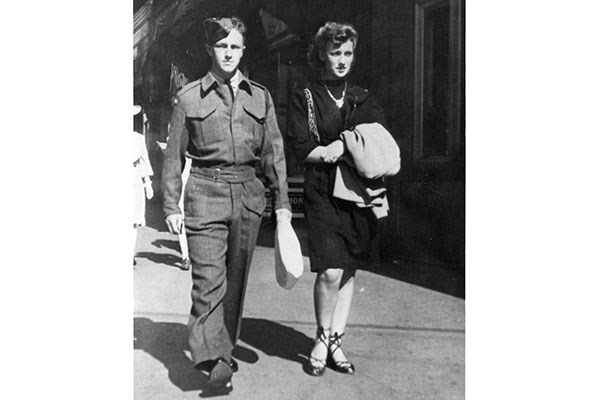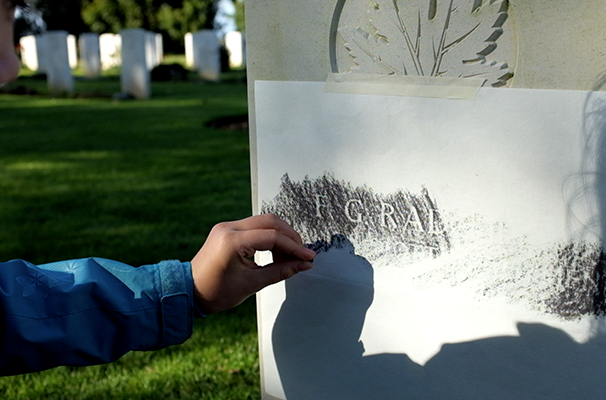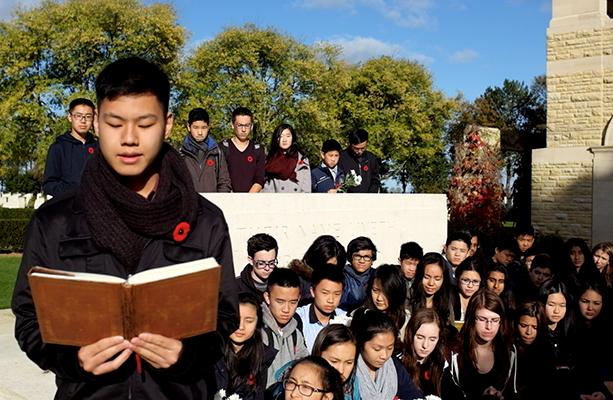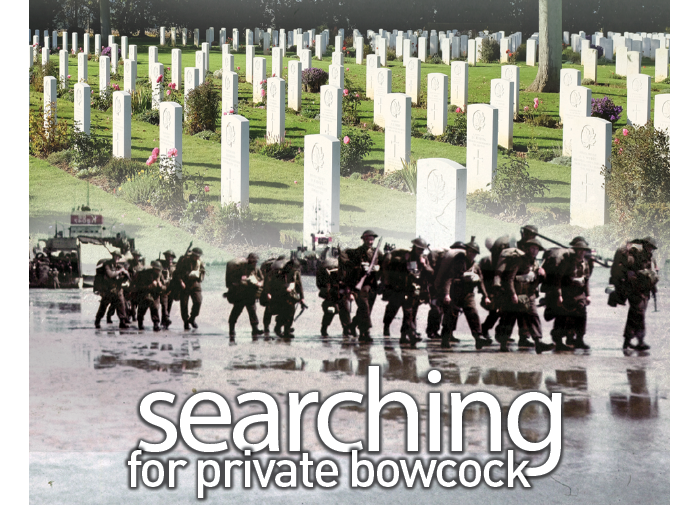Not much is known of Private Robert Spratt Bowcock. From the few archived records that exist, we know he appeared to be like any ordinary kid growing up in Richmond in the 1930s.
Born in Trail in 1925, Bowcock moved to Richmond at age six. His parents operated a small store on No. 5 Road as he attended the schools of Mitchell elementary and Richmond High. There, perhaps, he tossed pebbles into ditches, knocked marbles against a fence and whistled while he walked to and from home.
An archived photo shows Bowcock riding around the town on his bicycle with a group of friends. At the time, many of the adult men in Richmond would have been former First World War veterans, having acquired land on Lulu Island under the Soldier Settlement Act. Their memories of the war may have shaped Bowcock.

When the Second World War broke out, we know, from archived records, Bowcock had attempted to enlist unsuccesfully in the army at age 16. So, for two years, he sat at his desk in Richmond High, pondering the newspaper headlines that rushed across the country to the West Coast.
As the Nazis swept through most of Europe, Bowcock finally got his chance at 18 and soon after, he was sent to England with the First Canadian Scottish Regiment around March, 1944.
Bowcock’s grave can be found at the Beny-Sur-Mer Canadian War Cemetery in France, between Juno Beach and the town of Caen, an area of Normandy in which Bowcock likely died from Nazi fire.
It was July 8, 1944, when Bowcock died at just 19 years of age. He was only a few years older than the 43 Grade 9 and 10 students from Steveston-London secondary who visited his grave at Juno Beach last month as part of an educational tour of Italy and France.
“He was probably nervous and scared for his life, but knew (going to Europe) was the right thing to do,” said student Denise Choi, who has spent the better part of this school term studying the war.
When Bowcock passed, it had been just more than one month after the Allied ships landed in Normandy, lowered their small boats and gates and deployed roughly 160,000 men to storm the Nazi’s Atlantic Wall on D-Day, June 6, 1944.
Ten thousand casualties later, more than one million more soldiers, including Bowcock, marched inward toward Paris and Belgium. The Allies had hoped to capture the French town of Caen on D-Day but such a feat took more than a month. Ergo, it was the sacrifices of soldiers such as Bowcock that made that famous amphibious landing on Normandy’s beaches the success it has since become known for.

Bowcock — who has a road named after him — left behind a fiance, Irene Wagner, as well as his parents and a brother.
About one year prior to his death, in May 1943, while training in Vernon, a letter to a friend grants us insight into Bowcock’s life:
“Have you seen Irene lately? I sure wish this damn war was over so her and I could get married, but I guess there’s not much I can do about it except help get it over with,” wrote Bowcock.
Anglophones, said Choi, “were patriotic about their country — after all they came from Britain because Canada was a colony.” “They were eager to enlist in the war and it was also a source of employment at the time,” noted Choi, as the Richmond News sat down with a group of students to gather insight about their trip.
Because Bowcock was a private, he likely didn’t know much about what exactly he would eventually face in France, said Choi.
“He wasn’t a higher commanding officer so he would not have gotten the plans beforehand because they didn’t want to give soldiers too many details in case the enemy intercepted them. So it would kind of be like living in the dark,” explained Choi, who noted it was a long journey by train and boat from Canada’s West Coast to Europe.
While the students had fun in Rome and Paris, and learned first-hand about modern European culture and society on their two-week whirlwind tour, a sobering moment came over all of them when they visited Normandy and set foot on the beaches.
“Stepping onto the beach I expected to feel very emotional because we were walking on the same beach all these Canadian soldiers died on, and sacrificed their lives on, and I definitely did feel super emotional. And I felt proud to be Canadian, knowing these soldiers sacrificed their lives for us. That’s why we are here today,” said student Leanne Lau.
Choi said it sent “chills down my spine.”
At the time of their visit, the weather was fair, with the blue skies matching the colour of the sea, as described by Choi. This was in stark contrast to the weather on D-Day, when a storm had just passed through the region days before (nearly delaying the invasion and putting it in jeopardy).
Students were able to walk along Juno Beach, feeling the unstable sand beneath them, tasting the salty air, hearing the waves crash down on the sand and witnessing the seemingly insurmountable (now destroyed and eroded) bunkers that faced the Allied soldiers 71 years ago.
“It was good for us to see it. You read all about these wars and think ‘okay that happened.’ But when we walked along the cemetery, there are rows and rows of graves, and you think, ‘wow, all these people died.’ It was good to see the physical effects of the war and not just read about it,” said student Mark Cam, who read a poem, Our Boys, at the cemetery in front of the entire group.

The poem draws parallels between the students’ lives and that which Bowcock experienced.
“It described all the ordinary events of what a child would do, but, because of what happened in the Second World, War, they weren’t able to do these things anymore. It’s kind of like their childhood was taken. We related it to students like ourselves who would have enlisted to go to war,” said Cam.
Classmate Josh Yang agreed.
“It was very emotional knowing all these people near to my age were actually at war. And to know they died for our country,” said Yang.

French teacher Marina Carter was one of the organizers of the trip.
Aside from setting foot on the beaches, Carter said one of the more emotional moments was when the students visited the Juno Beach Centre museum.
There, a screen scrolled through all the Canadian casualties of the war. It would take a visitor 13.5 hours to see the list from start to finish.
“We sat there for a while and it was just the Ws. To me that was a ‘whoa’ moment, it was very emotional,” said Carter.
Another moving moment came when the students visited the Ardenne Abbey — site of the Ardenne Abbey Massacre — where the Nazis shot 20 Canadian soldiers in the backs of their heads in June, 1944.
Following the massacre, French farmers discovered the bodies in their fields. The students visited the graves and paid respect at a memorial outside the abbey.
“That was very touching for me, there were a lot of tears. I found that place very emotional. It was bone chilling to walk through and know these men were just shot and killed and buried,” said Carter.
The students took home newfound knowledge of the war and were able to make direct links to what they had learned in school textbooks. Case in point, student Kathleen Kong noted the abbey massacre would have been against the Geneva Conventions.
At the museum, the students were able to look at war artifacts, getting glimpses of what life was like at the time.
The students also meandered through Nazi bunkers and learned about specific anti-Nazi tactics employed in the war.
“We visited one of their bunkers and looked at the structure and saw how they did it. We saw how the workers who made it, who were forced into doing it, kind of sabotaged it by making it a bit unstable,” said Yang.
As well, the students learned about the contributions of women in the war.
“It was very busy for women at home — taking care of children, working in factories while their husbands and soldiers were out at war,” noted Choi.
Of course, the most important aspect in the visit to Normandy for these students, said Carter, was for them to not forget what happened and remember the moments of reflection they experience.
Noted Cam: “I think we can take away how devastating or just how sad it is, what we can come to as a race. There can be so much tension and hate. It’s a lesson for everyone that, even though these things have happened in the past, it shouldn’t happen again. Even the wars going on now, people are trying to put an end to them,” he said.

Student Jessie Chan said if we do forget what happened, it would be more likely such atrocities would repeat themselves.
“I think it could happen because the future is unpredictable. I know we’re living in a real safe place right now, but there are still wars going on and anything could happen,” said Chan.
All of the students said they were aware of what was happening in Syria.
In order to help prevent such crises from happening and/or escalating, Cam said international cooperation is needed.
“It would probably come down to the nature of human greed. Humans want more power, be it financially or just in general. So that’s something that needs to be addressed by world parties, such as the United Nations, to take a stand and put an end to that.”
Student photos by Sanford Lee.



